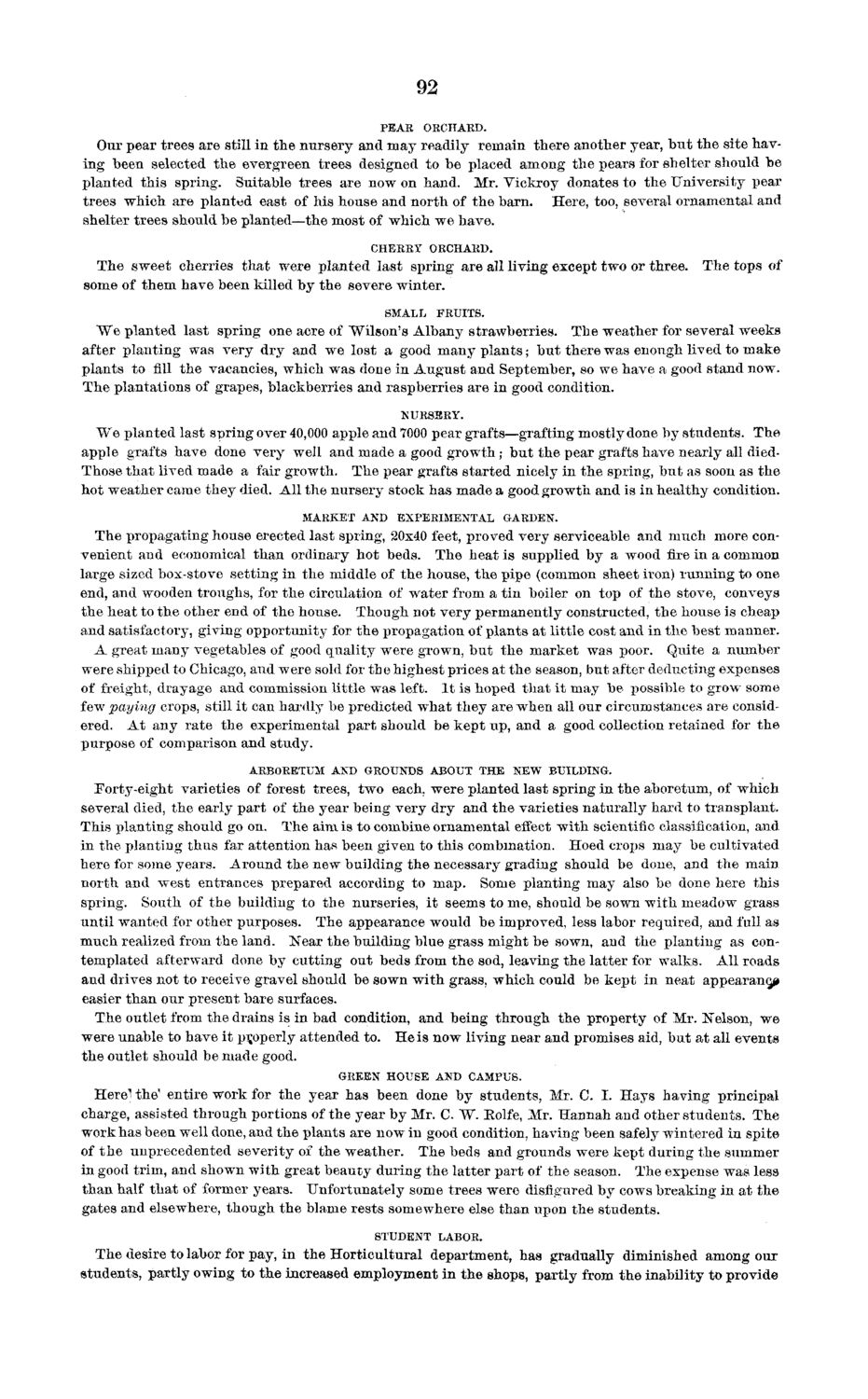| |
| |
Caption: Board of Trustees Minutes - 1873
This is a reduced-resolution page image for fast online browsing.

EXTRACTED TEXT FROM PAGE:
92 PEAR ORCHARD. Our pear trees are still in the nursery and may readily remain there another year, but the site having been selected the evergreen trees designed to be placed among the pears for shelter should be planted this spring. Suitable trees are now on hand. Mr. Vickroy donates to the University pear trees which are planted east of his house and north of the barn. Here, too, several ornamental and shelter trees should be planted—the most of which we have. CHERRY ORCHARD. The sweet cherries that were planted last spring are all living except two or three. The tops of some of them have been killed by the severe winter. SMALL FRUITS. We planted last spring one acre of "Wilson's Albany strawberries. The weather for several weeks after planting was very dry and we lost a good many plants; but there was enough lived to make plants to fill the vacancies, which was done in August and September, so we have a good stand now. The plantations of grapes, blackberries and raspberries are in good condition. NURSERY. We planted last spring over 40,000 apple and 7000 pear grafts—grafting mostly done by students. The apple grafts have done very well and made a good growth; but the pear grafts have nearly all diedThose that lived made a fair growth. The pear grafts started nicely in the spring, but as soon as the hot weather came they died. All the nursery stock has made a good growth and is in healthy condition. MARKET AND EXPERIMENTAL GARDEN. The propagating house erected last spring, 20x40 feet, proved very serviceable and much more convenient and economical than ordinary hot beds. The heat is supplied by a wood fire in a common large sized box-stove setting in the middle of the house, the pipe (common sheet iron) running to one end, and wooden troughs, for the circulation of water from a tin boiler on top of the stove, conveys the heat to the other end of the house. Though not very permanently constructed, the house is cheap and satisfactory, giving opportunity for the propagation of plants at little cost and in the best manner. A great many vegetables of good quality were grown, but the market was poor. Quite a number were shipped to Chicago, aud were sold for the highest prices at the season, but after deducting expenses of freight, drayage and commission little was left. I t is hoped that it may be possible to grow some few paying crops, still it can hardly be predicted what they are when all our circumstances are considered. At any rate the experimental part should be kept up, and a good collection retained for the purpose of comparison and study. ARBORETUM AND GROUNDS ABOUT T H E N E W BUILDING. Forty-eight varieties of forest trees, two each, were planted last spring in the aboretum, of which several died, the early part of the year being very dry and the varieties naturally hard to transplant. This planting should go on. The aim is to combine ornamental effect with scientific classification, and in the planting thus far attention has been given to this combination. Hoed crojjs may be cultivated here for some years. Around the new building the necessary grading should be done, and the main north and west entrances prepared according to map. Some planting may also be done here this spring. South of the building to the nurseries, it seems to me, should be sown with meadow grass until wanted for other purposes. The appearance would be improved, less labor required, and full as much realized from the land. Near the building blue grass might be sown, and the planting as contemplated afterward done by cutting out beds from the sod, leaving the latter for walks. All roads and drives not to receive gravel should be sown with grass, which could be kept in neat appearance easier than our present bare surfaces. The outlet from the drains is in bad condition, and being through the property of Mr. Nelson, we were unable to have it properly attended to. He is now living near and promises aid, but at all events the outlet should be made good. GREEN HOUSE AND CAMPUS. Here'; the' entire work for the year has been done by students, Mr. C. I. Hays having principal charge, assisted through portions of the year by Mr. C. W. Eolfe, Mr. Hannah and other students. The work has been well done, and the plants are now in good condition, having been safely wintered in spite of the unprecedented severity of the weather. The beds and grounds were kept during the summer in good trim, and shown with great beauty during the latter part of the season. The expense was less than half that of former years. Unfortunately some trees were disfigured by cows breaking in at the gates and elsewhere, though the blame rests somewhere else than upon the students. STUDENT LABOR. The desire to labor for pay, in the Horticultural department, has gradually diminished among our students, partly owing to the increased employment in the shops, partly from the inability to provide
| |